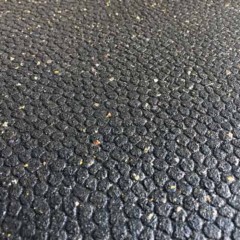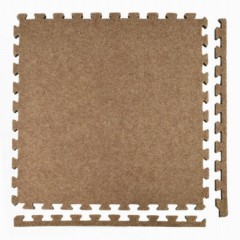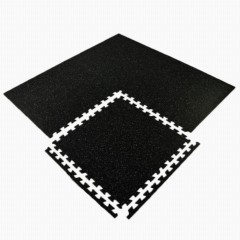Types of Interlocking Floor Mats
Interlocking floor mats from Greatmats deliver a professional look while remaining easy enough to use for a DIY project. We offer multiple materials in these floor tiles and mats, which gives you a range of potential usages.
Interlocking Mats & Tiles
Interlocking floor mats can fill a number of use cases because of the wide range of designs from which you can choose. Multiple colors and textures help you develop the exact kind of look you want to see in the room. Pick among:
- Bright colors
- Safe and durable
- Carpet texture
- Perforated design
- Pebble texture
- Simulated wood grain
- Smooth rubber interlocking floor tiles
Materials
With a wide range of materials available, it’s easy to select the perfect interlocking floor mat or tile for your particular needs.
Interlocking rubber floor mats have significant durability, but they’re typically limited to black colors. EVA foam tiles are cushioned, while PVC plastic and carpet provide good durability and some cushioning.
Use Cases
Interlocking rubber tiles are ideal in a garage gym space with free weights or exercise machines. They also work well in commercial gyms.
Foam, carpet, and PVC plastic tiles work well for residential use, providing a stylish design. Interlocking PVC tiles are also popular for industrial use.
Interlocking Floor Mats Q&A
Can you use interlocking flooring in a basement?
These materials work well in a basement area because most of them are water resistant. Basements sometimes have moisture seeping through the foundation, leading to potential problems with dampness, meaning a
water-resistant basement flooring is important.
How does interlocking tile flooring work?
The foam and rubber mats or tiles all work in a similar manner. They have a puzzle-style edge, where
the edges interlock when pressed together. PVC plastic tiles usually have a tab and loop system, where hidden interlocking edges snap together.
How do you install interlocking floor mats and tiles?
The edges will fit tightly, so place them down, align them, and
then push or step on them. There's no need for adhesive on the subfloor or
on a hard surface.
What is the easiest flooring option to install?
Puzzled edging or loops and tabs allow the tiles to interlock together quickly, while also allowing for disassembly later, greatly
simplifying the flooring installation. Interlocking foam floor tiles have another advantage because some are double-sided. Just flip them over and use the underside for a fresh appearance. This design maximizes the useful lifespan.
 $74480 /Kit You Save 20%$3.43/sqftShop$1,11720 /Kit You Save 19%$4.12/sqftShop$1,02144 /Kit You Save 19%$4.05/sqftShop$26275 /Kit You Save 33%$2.71/sqftShips Out in 1-3 Working DaysShop$52550 /Kit You Save 33%$2.71/sqftShips Out in 1-3 Working DaysShop$1,04995 /Kit You Save 34%$2.71/sqftShips Out in 1-3 Working DaysShop$1,57650 /Kit You Save 34%$2.71/sqftShips Out in 1-3 Working DaysShop$3213 /Tile You Save 19%$3.89/sqftShips Out in 1-3 Working Days SustainableShop$2791 /Tile You Save 20%$3.38/sqftShips Out in 1-3 Working Days SustainableShop$1308 /Tile You Save 20%$3.56/sqftShop$1386 /Tile You Save 19%$3.78/sqftShop$1668 /Tile You Save 20%$4.54/sqftShop$1308 /Tile You Save 20%$3.56/sqftShop$1199 /Tile You Save 20%$3.27/sqftShips Out in 3-5 Working Days SustainableShop$1786 /Tile You Save 20%$4.87/sqftShop$15003 /Tile You Save 9%$13.94/sqftShips Out in 3-5 Working Days SustainableShop
$74480 /Kit You Save 20%$3.43/sqftShop$1,11720 /Kit You Save 19%$4.12/sqftShop$1,02144 /Kit You Save 19%$4.05/sqftShop$26275 /Kit You Save 33%$2.71/sqftShips Out in 1-3 Working DaysShop$52550 /Kit You Save 33%$2.71/sqftShips Out in 1-3 Working DaysShop$1,04995 /Kit You Save 34%$2.71/sqftShips Out in 1-3 Working DaysShop$1,57650 /Kit You Save 34%$2.71/sqftShips Out in 1-3 Working DaysShop$3213 /Tile You Save 19%$3.89/sqftShips Out in 1-3 Working Days SustainableShop$2791 /Tile You Save 20%$3.38/sqftShips Out in 1-3 Working Days SustainableShop$1308 /Tile You Save 20%$3.56/sqftShop$1386 /Tile You Save 19%$3.78/sqftShop$1668 /Tile You Save 20%$4.54/sqftShop$1308 /Tile You Save 20%$3.56/sqftShop$1199 /Tile You Save 20%$3.27/sqftShips Out in 3-5 Working Days SustainableShop$1786 /Tile You Save 20%$4.87/sqftShop$15003 /Tile You Save 9%$13.94/sqftShips Out in 3-5 Working Days SustainableShop





























































